REFLECTION: SUBJECT: Time: An Investigation into Food Decay
Posted: April 15, 2014 Filed under: Documentation, Subject | Tags: Art, art reflection, Art Student, artist, Decay, Food Decay, looking back, Mold, Mould, reflection, subject 2 CommentsLooking back at my subject work, I have really worked out of my comfort zone and steered away from the work I would typically create. When thinking about time as a brief, I instantly thought about things changing over time. After coming across Sam Taylor Wood’s “Still life” piece, I embarked on working on artistically portraying an investigation into food decay. I have used physical mould and decay as a medium to produce art and I have also tried to replicate the look of mould using mixed media techniques. I have enjoyed using materials that are not typically for use within art, like sugar and cotton wool and it has opened my eyes to the fact that it is how you use an d manipulate the material you are working with that creates successful art work, not the material itself.
I think the bread filled perspex box that I have produced is particularly successful because it gives me and the viewer an insight into how things decay. We would not usually leave bread to decay for that long in our households and so it allows others to see the colours that moulds produce and the hidden beauty of the natural things that we take for granted or find repulsive. I also feel that my photographs and video of my decaying art piece are particularly successful as they accurately capture change and decay over time. Also, visually beautiful photographs have been captured even though they are portraying something repulsive. I do wish that I could have left the piece to decay for longer but I simply did not have the facilities to do so safely. My experimentation with photo montage produced interesting outcomes and highly unusual subject matter to paint from. Working with Petri Dishes was a success in my eyes as they gave clarity and added a sense of realism to the fake mould that I had painted within them. It also encourages people to question what they think they see. I have never really worked with 3D or sculpture before and I think that my sculptural final piece for this project is a success. It is visually appealing and there is a strange juxtaposition going on between the perfectly formed fruit and the fake decay mouldy looking exterior.
Looking back, I do not feel that the coloured mould experiments I produced were particularly successful. I feel that they don’t really fit in with the rest of the work made within this project and that they almost look to appealing to the eye and no longer look mouldy or as if they are portraying decay. Filling perspex boxes with vegetables and fruits and photographing them was also unsuccessful as when the foods decayed they leaked liquids that the boxes simply couldn’t contain. They also attracted bugs and fruit flies and I had to get rid of them in fear of my health and the welfare of other students that were working near my desk.
In conclusion, I feel I have managed to create a substantial investigation into food decay inspired by a variety of artists and full of experimentation with materials and techniques. I think I have managed to capture a frozen moment in the decay process using artist materials a well as portraying how decay develops over time through 3D work and photography. I have analysed whether this body of work can be considered art and decided that setting is incredibly important in this. I have successfully created two final pieces that definitely demonstrate an investigation into food decay and worked with a subject that I feel has shown me and others that there are fascinating things out there that on a daily basis we take for granted.
SUBJECT: Final Piece: Decaying Sculpture: Fruit Bowl
Posted: April 12, 2014 Filed under: Documentation, Subject | Tags: 3d, a frozen moment, Art, Art Student, art work, artist, artistic representation, beauty, bowl, cotton wool, Decay, decay art, decay process, decay sculpture, documentation, final art piece, final piece, Fine Art, fine artist, fruit bowl, investigation into food decay, modelling paste, Mold, Mould, mould art, moulding sculpture, paint, rotting fruit, Sam Taylor Wood, sculptural piece, subject, Sugar Leave a commentWithin the Subject module that I have been undertaking, I have been looking at two elements of food decay: The growth of Decay and its Documentation over time and producing fake mould that captures a frozen moment within the decay process. I have worked with the juxtaposition of the pretend and reality and tried to portray something that people consider to be horrible as more beautiful and accepted.
For this Final Piece, I have worked with the idea of capturing a frozen moment, after perfecting the look of producing fake mould through the use of sugar, paint, cotton wool, modelling paste etc. I have decided to use that skill to consolidate my findings and produce a 3D sculptural outcome.
The Initial Inspiration for this projects subject matter was a video piece called “Still Life” by Sam Taylor Wood. This piece documents the decay of a fruit bowl and in detail portrays how it decays over a period of time. Without coming across this time-lapse, I don’t think I would have embarked on this project and so it seemed fitting that as a final piece, I make a response to this video piece. In Sam’s work, She has captured how the fruit bowl changes over time, I have juxtaposed my work with this by almost producing a still of mould and decay overtaking a fruit bowl.
There is interesting ideas at work within this piece, there is a strange juxtaposition between the perfectly formed fruit and the replica mould that appears to be incredibly far in the decay process. I believe that this piece consolidates the findings of this project and brings together what I have been experimenting with and learning both conceptually and practically. In terms of concept and what I have learnt in my investigation into food decay, this piece highlights the fact that in the right setting, even mould and decay and be appealing and can be a piece of art. It makes people consider it as a piece of art and I think in doing so would and could make some of the public more open-minded about the art world.
In think this piece is successful in portraying the beauty of things that typically we would overlook. It makes you want to look at the colours and textures that I have created to replicate mould and from talking to my peers at first it initially makes the viewer wonder what they are looking at and confuses the mind. In my opinion, the piece is quite visually beautiful. I also think it is successful in creating a strong juxtaposition between the perfectly formed fruit and the mouldy exterior. Furthermore, this is a still life, capturing a still of decay and replicating something that would in nature change over time. I think this piece is highly successful in showing what I have learnt, How I have acquired this knowledge and what it has been inspired by. It is almost a homage to Sam Taylor Wood’s work and there is a direct opposition between our concepts. This piece brings an end to my subject module. As well as documenting decay, making people question reality and consider mould as art, I believe it is a visually appealing sculptural piece that encourages people to consider mould as an art medium. Even though it is not created from real mould and decay, for a moment it makes people wonder whether it is and broadens their horizons. I think it shows people how much beauty you can miss and makes you consider that things as simple as some mould on a yoghurt in the fridge can be attractive and how much we miss out on and take for granted.
Undertaking this project has opened my mind into what I take for granted in nature and has given me the opportunity to document and notice changes undergone during Food Decay myself and to produce art in response to what I see and think about visually.
Because this is a final piece, I wanted it to look polished and finalized. I decided to photograph is professionally with lighting and a grey gradient background to achieve shadows and to show the details of the piece on camera.
I have thoroughly enjoyed this project, The work I have created within it is not typically the kind of work I would usually create and so it has been incredibly interesting to work out of my comfort zone and I have learnt a lot about myself as an artist and as a person.
UPDATE: THE CHANGES OF MY MOULDING PETRI DISH ART WORK
Posted: January 30, 2014 Filed under: Documentation, Subject | Tags: Acrylic Paint, Art, Art Student, artist, Arts, Artwork, bread, Decay, fake mould, Food, Food Decay, Mixed media, Mold, Mould, Moulding art, Mouldy, paint, Petri dish, Petri Dish Art, real mould, Time Leave a commentWithin my subject module, as things physically change over time, it is highly important to document the developments of my work and take photographs of things that have moulded. Here are some images of my moulding Petri Dish artwork, It has demonstrated the juxtaposition between real mould changing over time and the mould that I created being a frozen moment in time highly accurately. The Fake moulding dishes have not changed but that cannot be said for the real moulds.
With this Idea, I wanted to portray the concept of the juxta position and relationship between real and fake moulds. I also wanted to portray the fact that the things we throw away and take for granted i.e. moulding food can be art and can be seen in a different light. It is so interesting to see how these litle petri dishes have changed over the christmas holiday and it is a shame that we miss a lot by ignoring it or in this case, binning it before it gets to this stage. Below are some particularly interesting dishes and changes that have occured:
In this project, I set out to investigate and capture food decay, I wanted to create an interesting art project and pieces that is not typical or usually thought of as art. I think I have definitely been successful in adhereing to both of these goals within this piece and the whole body of work that I have created.
I have captured decay that we wouldn’t usually get to see and I have used mould to create art pieces, I have also reigned my ideas in from watching things mould and created fake moulds using art materials and paints. Juxtaposing these two elements within this piece has brought my project together and makes it feel a lot more consolidated as a whole. I will continue to work with these ideas and think about reflecting and discussing whether I consider my work to be art at all.
UPDATE: The Decay of Bread and Teabags in Perspex Boxes: 4 months
Posted: January 16, 2014 Filed under: Documentation, Subject | Tags: Art, Art Student, artist, Box, bread, Decay, decay over time, documentation, Fine Art, Mold, Mould, mould sculpture, moulding, mouldy art, perspex boxes, sculpture, teabags, Texture, Time, visual art Leave a commentMy moulding perspex box sculptural pieces are becoming even more interesting. I have never left items to go mouldy for this long before. It has been about 4 months now, you would never leave bread for example to mould for that long in your household fridge or home cupboards. Below are some images i’ve taken of the boxes at this stage in their progression.
The tea bags seem to have reached a stage where they are not moulding rapidly anymore. They have a furry exterior developing on them and a greeny tinge growing on the bags but this hasn’t progressed as quickly as it was in the last three weeks. The bread box is a highly successful piece, it continues to mould day by day, it is no longer even recognisable as piece of bread, what has suprised me most that I never predicted would happen is the amount that it has shrunk within the box. There is an aray of texture and colour developing on the bread, the yellow spots are particularly interesting and an unusal surface is developing. I will continue to document these boxes and blog more stages of their moulding until my final assessment.
Subject Feedback: Time Project: An investigation into Food Decay
Posted: December 19, 2013 Filed under: Documentation, Subject | Tags: Art, art degree, art feedback, Art Student, artist, constructibe criticism, Decay, documentation, feedback, Fine Art, formative assessment, investigation into food decay, Mould, subject, Time, time project Leave a commentI was pretty pleased with the Feedback I received in conjunction with my Time project, considering it was the first formative feedback point of my Degree. I didn’t really know what to expect, I have worked really hard and was really hoping that was recognised and portrayed within my work. A system of Tick boxes was used under different categories ranging from very poor and insufficient up to excellent. I managed to achieve my ticks in the second from top box, The comment being very good, professional and interesting.
I was happy with the mark I achieved and the words that described my work, I was also given very valuable feedback, positive points and ways to improve my body of work. My tutor said I have had a strong term of experimenting with many different mediums and bring great enthusiasm and dedication to my practice. They said I had produced a large amount of work around my mould theme but in my diligence and hardworking enthusiasm there seems to have been little time for reflection. A criticism was given that it was not clear what my two final pieces were and that it would be interesting to reflect on whether I consider my work to be art at all. Another criticism was that there has been little cross-fertilization from the lessons learnt in undertaking workshops into my studio practice. I do feel I have used what I have learnt in workshops but may be this is not made clear enough and there is no harm in doing more. There were many positive points in this feedback and my tutor talked about how I had really good contextual referencing both in my notebooks and on my blog. They said my blog was really well executed which I was particularly proud of considering I have never blogged before.
The underlying point of my feedback was that all that is missing from my work is TIME FOR REFLECTION.
From this feedback, I got the impression that I had worked well and had a very good first term on my degree programme. The Criticisms seen here, are things that I can work on and improve my work and attitude as an art practitioner as a whole. I will make critical judgement on my work, experiment with incorporating things I’ve learnt in workshops into my work more, reflect, write a piece on whether I consider my work art and reflect some more. I will make it clearer which pieces I have chosen to be my two final pieces and reflect on why. After this I am hoping that I will have satisfied more of the criteria set and boost my grade upwards. Overall, I am pleased with how I have done and am glad that I clearly know how to improve on it.
FINAL PIECE: PETRI DISH ARTWORK: The Real and the Not Real…
Posted: December 4, 2013 Filed under: Contextualisation, Documentation, Subject | Tags: 3D piece, Art, artist, artistic, Artwork, Decay, documentation, fake mould, Fine Art, juxtaposition, Mold, Mould, mouly, Petri dish, petri dishes, real mould, Scientific, sculpture, Vija Celmins, visual art Leave a commentThe initial inspiration for this final piece using petri dishes to create an art piece was a mug I forgot about that still have some tea in it. After I eventually remembered about it the bottom had started to mould and reminded me of how a sample in a petri dish sometimes looks. I instantly thought about the more scientific side to things decaying and started to work on how I could incorporate Petri Dishes into an art piece. Below is an image of the mug that inspired this thought.
I immediately got hold of some petri dishes and started filling them with things that would decay over time, like bread, milk, yoghurt, tea, juice and combinations of two or more of these ingredients. I wanted to see how they moulded in a dish with little air and different conditions to how I have moulded things before. At this point, I was not really sure how I was going to use these pieces to create an art piece but I was confident that eventually I would. Below are images of some of the petri dishes before and after they have started to mould. Some of them have become very interesting objects and will continue changing over time but I did not feel that displaying these objects alone as art was enough.
I decided to paint the inside of some more petri dishes with fake mould to create a juxtaposition between the real and the not real. This idea was inspired by Vija Celmins “to fix the image in memory” which plays with post perspective by asking what is real? In this work, there are two rocks, one is real and one is an imitation. There is the same principle as a hall of mirrors. This undoes the notion of realistic artwork because we have no idea which one is art.

To fix the image in memory series – Vija Celmin
Creating real and fake moulding petri dishes and displaying them altogether does make the viewer ask themselves which ones are art? Are they all art, as one piece? Are the petri dishes miniature paintings or symbols of decay? that is up to you. By doing this, I have tried to show a juxtaposition between things changing over time (real mould) and preserving time or capturing a moment in the decay process (fake mould). Interesting things are happening when displaying these two notions together. In my opinion the piece that I have created from petri dishes is one of my most successful.
The juxtaposition between the real and the fake within decay is something I have explored over and over throughout the project and I feel that this piece sums up my findings accurately which is why I chose to display it as a final outcome. Also, it almost bridges a gap between science and art and I like how it looks aesthetically. It will be interesting to see how the real Petri dishes mould over time and how they look in relation to the ones I have painted. It is interesting that this final piece will continue to decay.
A Few Quick Drawings from my Sketchbook
Posted: December 3, 2013 Filed under: Documentation, Subject | Tags: Art, biro, charcoal, Cross Hatching, Drawing, Fine Art, indian ink, Ink, Mixed media, Multiple Media, Pencil, sketchbook, sketches, Visual Arts, wash, Wet-on-wet 1 CommentHere are a few drawings from the sketchbook that I have been keeping throughout this project. I have experimented with a variety of drawing materials and techniques to formulate this book.
I have experimented with Continuous Line drawing, Drawing with ink wet on wet and wet on dry and then drawing into it, Drawing onto grounds, Drawing onto washes that look like mould, Pencil Drawings, and Drawing with Biro, Fine Liner and Charcoal. I have used charcoal pencil to draw into black indian ink and produced some succesful results using this technique. Drawing moulding food is something I have been doing as a starting point to help me move my project forward when I’m not really sure where I’m taking it. I also think it is important to keep drawing as inspiration for the pieces you are going to create. As this project is about TIME, I have been producing some quite expressive timed drawings as well. These time drawings range between 10 seconds and five minutes.
Drawing Workshop: Anthropomorphasis
Posted: December 1, 2013 Filed under: Contextualisation, Documentation, Subject | Tags: Art, Artists, Artwork, charcoal, Color, draw, Drawing, Fine Art, Graham Sutherland, Henri Matisse, inspiration, Model (art), Oil pastel, Plant, Visual Arts, Workshop Leave a commentIn this drawing workshop, I was encouraged to experiment with anthropomorphism. Anthropomorphism is the attribution of human form or other characteristics to anything other than a human being. In this case, we were looking at the attribution of human motivation with plant life and natural phenomena. As well as the relation between the plants and the model, we looked at relief work and experimenting with cutting paper out and sticking it onto our drawings to make a much more free image and shape than just the rectangle of the paper we were given. There were a few initial artistic inspirations that were considered before creating the outcome. This workshop was from life so a life model surrounded by plant life was present. The artists that stood out to me to inspire my piece were Henri Matisse, Graham Sutherland, Ruth Daniels and Georgia O’Keeffe.
HENRI MATISSE
Henri Matisse favoured drawing from life. It is interesting to look at his piece below because the plants almost seem more important in the composition than the figure does. I am drawn in by the loose handling used to render the leaves and the fact that the leaves are varied in size and shape. To me, the plants are a far more interesting subject to look at within this painting and I don’t immediately notice that she is there. This inspired me to think about displaying the figure or face of a human woman amongst the foliage around her. Matisse’s work inspired me to use a bright colour palette and to not be too controlled in my approach. This piece also gave me an insight into how the plants and the model can come together to make a successful artwork.
GRAHAM SUTHERLAND
Graham Sutherland’s piece “Bamboo forest“ showed me how I could approach drawing and incorporating an expressive element into my piece. I like the limited colour palette in this work and it inspired me to fill the page and cram lots of plant imagery together. Here he has portrayed the plants dominating the figure and there is a sense that the figure is intimidated by all the foliage. I wanted the figure and plants to be harmonious together in my work so in a way Sutherland’s work showed me how to do that by showing the how not to do it.
RUTH DANIELS and GEORGIA O’KEEFFE
The Bright colours in the work of these two artists were highly inspirational to me, they influenced me to use iridescent colouring within my own work and think about placing colours together to make a more striking effect. The Blending of colours was something that caught my eye here aswell which inspired me to be tonal in my work rather than thinking about the use of block colour.
MY ANTHROMORPHIC ARTWORK
Above is an image of the piece I produced within this workshop. I am fairly happy with how it turned out and the model and the plant life have definitely come together as one. The bright colour palette and leaves remind me of a carnival atmosphere. I think the fact that the shape of the piece is irregular adds to its success, it would not be as interesting to look at if it was simply rectangular. To create this piece I have used a variety of medias including charcoal, oil pastels, paint, ink and chalk pastel. I think leaving some of the piece white was definitely a wise decision as it heightens and accentuates the bold colouring of the piece. I found it quite difficult to decide which bits of the life model and plants that I was looking at to include in my work and struggled at first to be selective. This workshop taught me that you do not have to draw all of what you see for the image to be successful and that you can combine two or more completely separate subject matters relatively simply.
Does the Colour of Food Mould and Decay Add to the Stereotypical Repulsion of it?
Posted: November 25, 2013 Filed under: Documentation, Subject | Tags: Acrylic Paint, Art, bright, canvas, Color, Colourful, colours, cotton wool, Decay, documentation, fake mould, Fine Art, Food, Mixed media, Mold, Mould, paint, Paintings, Sugar, Texture, visual art Leave a commentDOES THE COLOUR OF MOULD ADD TO THE HUMAN REPULSION OF IT?
IF IT WAS A DIFFERENT COLOUR, WOULD IT BE LESS REPULSIVE AND THEREFORE MORE ATTRACTIVE?
IF YOUR FOOD SUDDENLY DECAYED IN BRIGHT, APPEALING COLOURS WOULD YOU BE LESS DISGUSTED BY IT?
These are some of the questions I asked myself when producing this series of six different coloured moulding canvases.
To me, It is obvious which one of these paintings looks like mould because of its colour!
In these six pieces, I have experimented with making mould in exactly the same way as I have in past replica moulding canvases. However, here I have painted them in more attractive colours as well as the stereotypical greeny brown colour that mould is. The textures and materials used are exactly the same in all of the pieces but the colour of the pieces definitely change how you think about them and their visual appearance a lot. In my opinion, this set of six as individual pieces and as a piece as a whole are highly successful.
Although all of the pieces are incredibly interesting, THE GREEN COLOURED CANVAS IS THE ONLY ONE THAT REALLY LOOKS LIKE IT COULD BE MOULD. Therefore, the colour of mould DOES effect our ability to identify it and our repulsion of it. The fact that colour affects how we associate and see things is an interesting concept indeed. My experimentation here was a success and my assumption turned out to be correct, colour is a massive contributing factor to our understanding of what something is or what something looks like.


























































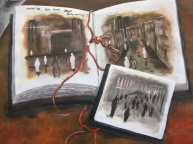

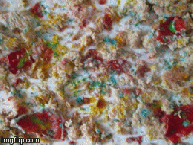
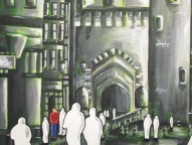


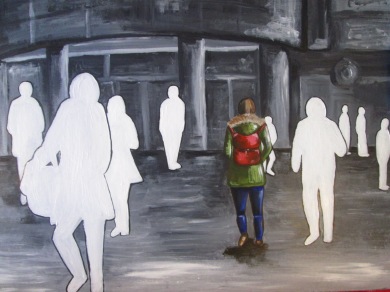
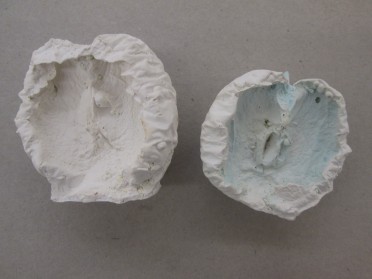







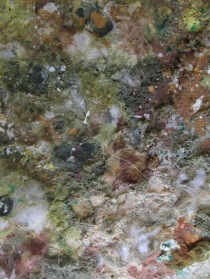
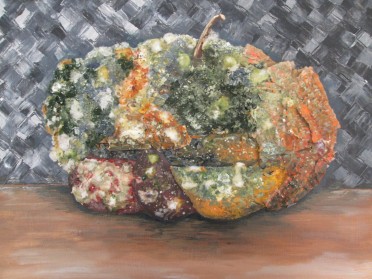
Recent Comments